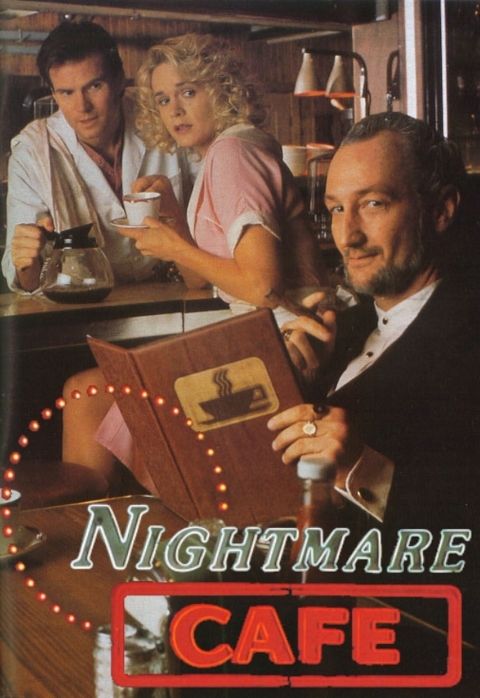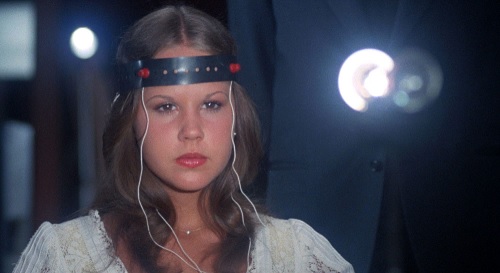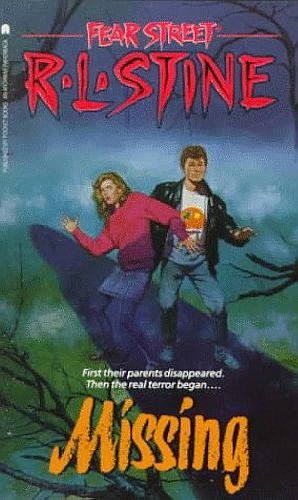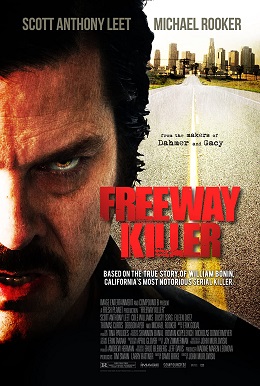Welcome to Late Night Retro Television Reviews, a feature where we review some of our favorite and least favorite shows of the past! On Mondays, I will be reviewing Nightmare Cafe, which ran on NBC from January to April of 1992. The entire show is currently streaming on YouTube!

Created by Wes Craven and Thomas Baum, Nightmare Café was an anthology show about a mysterious café and the people who worked there. The proprietor was played by Robert Englund. The series only aired for six episodes and apparently, NBC didn’t really give the show much of a chance to find an audience. Myself, I just recently came across it on YouTube and I’m looking forward to reviewing it over the course of October!
Episode 1.1 “Nightmare Café”
(Dir by Phillip Noyce, originally aired on January 29th, 1992)
“See those two folks up there?” Robert Englund, playing a sharply-dressed man named Blackie, asks while staring straight at the camera. “They’re about to get a second chance. And you know what? I bet they blow it.”
The two people to whom Blackie is referring are Frank Nolan (Jack Coleman) and Fay Pernovic (Lindsay Frost). On a foggy night, Fay stops her car on the side of the bridge and jumps into the water below. Fortunately, Jack already happens to be in the water so he grabs her and pulls her to dry land. Standing on the deserted road and soaking wet, Fay refuses to say thank you and Frank refuses to mention why he was there to begin with. However, when they see an all-night café in the distance, they decide to get a cup of coffee. As they head to the café, Blackie watches them from the shadows. As they enter the café, the neon sign changes from saying “Night Café” to “Nightmare Café.”
The café appears to be deserted, though in working order. Jack goes behind the counter finds a chef’s outfit. Fay finds a waitress outfit. When she heads into the restroom to change clothes, she briefly hears the sound of a woman crying but, upon entering, she finds no one. Meanwhile, Jack notices that a TV screen at the front of the café has come to life and …. uh-oh! He’s suddenly watching what appears to be security footage of Fay removing her wet clothes. Jack does the right thing and turns the TV off but seriously, what’s happening with this place!?
In the restroom, Fay marvels at how well the waitress uniform fits, almost as if it was made for her. Suddenly, she hears more crying. She touches the bathroom mirror and she sees herself sobbing and pulling pills out of a medicine cabinet.
Fay steps back into the main part of the café. Frank confesses about watching her change on the television. Fay demands to know what color underwear she was wearing. “White …. with red hearts on back,” is Frank’s reply. (For the record, as I sit here typing this, I am wearing black underwear with red hearts on the back.) Fay accuses him of being a pervert and peeking in on her while she was changing. Frank turns on the TV in an attempt to prove that he’s not a perv but, instead of showing the restroom, the TV shows the chemical plant where, according to Frank, he works as a night watchman. He watches as two men steal a barrel of chemical waste and brag about how they’re going to dump it into the harbor. Frank says that his worst nightmare is seeing something that’s wrong and not doing anything to stop it. Fay pinches Frank in an attempt to wake him up. On the TV screen, Frank Nolan tries to stop the men from driving off with the chemical waste. Frank is fired and then knocked unconscious.
Realizing the Frank has vanished from the café, Fay runs over to a payphone and dials 9-1-1, just to be informed that the number cannot be reached. Fay opens the door to the café and discovers that she and the café are apparently floating in space!
Returning to the television, Fay sees that, at the chemical plant, Frank is still on the ground and his employer tells a bunch of thugs that he wants them to make Frank watch as they dump the waste into the harbor. However, once the thugs drive down to the harbor, Frank jumps out of the trunk of their car and into one of the trucks transporting the chemical waste. The thugs shoot at the truck until it explodes and then decide that it’s time to get a cup of coffee.
Realizing that the thugs might be coming, Fay decides she better pretend to be a real waitress. She grabs a cup of coffee and walks into the back where she discovers Frank rising out of a water-filled sink. “You know what?” Frank says, “I don’t think this is your run-of-the-mill all night café!”
Fay congratulates Frank on doing the right thing and standing up to the thugs. Suddenly, Fay starts to worry about what she saw in the restroom so she and Frank enter and, in the mirror, they see the two thugs approaching the cafe. Frank and Fay run into the kitchen. Frank opens a door marked exit and plunges back into the harbor. Fay closes the door and then opens it again and finds herself staring at a back alley. Deciding to face the thugs, she heads to the front of the café, where the two thugs demand to know where Frank is. She tells them that he’s in the ladies room. They rush into the restroom and suddenly find themselves on a police shooting range with a bunch of cops aiming their guns at them.
“This place has possibilities,” Fay says as the two thugs run from the café.
Suddenly, the TV turns on Fays sees herself in her bedroom, getting dressed for a date. Frank steps back into the café and watches the TV, barely noticing that Fay has vanished from the café. While he’s doing this, Blackie steps into the café and, breaking the fourth wall, says, “This ought to be interesting.”
On the television, Fay gets a call from a guy named Al (John D’Aquino) who explains that he’ll be delayed but he’ll see her later. Frank recognizes Al as being his boss at the chemical plant and then he realizes that Blackie also worked at the chemical plant and was one of the people who always told him not to waste his time reporting the toxic waste dumping. Blackie holds up a deck of cards and says that whoever pulls the low card will pay for their meal. Frank says that the only person that he’s betting on is Fay.
On the TV, Fay drives towards Al’s house. Suddenly, Frank is standing on the side of the road and hitchhiking. Fay gives him a ride and suddenly, the two thugs pop up and start shooting at them. Fay speeds off, with Frank in the car. Fay outmaneuvers the pursuing thugs, who end up crashing their car into the harbor.
Suddenly, Blackie is the only one sitting in the café. He watches Fay and Frank talk in the car. Frank tells Fay all about Al and Fay kicks Frank out of the car, not understanding how he could possibly know her name. Suddenly, Frank is back in the café. He and Blackie watch as Fay knocks on the door of Al’s penthouse. No one answers and Frank cheers as Fay starts to walk away. Suddenly, Blackie appears on the television and unlocks the door so Fay can enter the penthouse.
Fay gives Al a really ugly sweater for his birthday but is then shocked to discover that Al is at the penthouse with another woman (played by Carrie-Anne Moss in an early role), who promptly asks if Fay is the maid. As Fay heads for the penthouse’s bathroom, one of the thugs shows up and announces that he previous saw Fay at the café. Meanwhile, Fay searches the medicine cabinet for pills before heading back to her car
Seeing Fay driving towards the harbor on the television, Frank runs out of the café to save Fay again. But this time, instead of jumping into the harbor, Fay looks at the water and then says that it would be foolish to kill herself over a loser like Al. Suddenly, Al drives up and Fay and Frank have to jump into the water to avoid getting hit. However, once they hit the water, Frank realizes that they’re already dead.
Upon figuring this out, Frank and Fay are transported back to the café where Blackie tells them that they’re dead in the real world but they’re alive in the café and now, they get to make a difference in other people’s lives. Blackie opens the door, to show Frank and Fay that they are once again floating in space and that the Earth in the distance. Blackie tells them that they’ve been selected by “a higher authority” to help the people who enter the café and “maybe learn a little about yourselves along the way.” But they’re both dead so what’s left to learn?
Suddenly, Al enters the café. Blackie tells Al that Frank and Fay are in the restroom. Al steps into the restroom and suddenly has a vision of Fay testifying against him in court. Terrified, Al runs from the café but, upon opening the door, he plunges through space and lands in a vat of chemical waste.
A woman (played by Joan Chen of Twin Peaks fame) opens the front door. “Hi,” she asks, “Are you open?”
Nightmare Café only ran for 6 episodes and anthology shows are notorious for being uneven. All that considered, I really enjoyed the pilot for Nightmare Café, with its twisty plot, frequently surreal visuals, and — last but not least — Robert Englund having what appears to be a lot of fun as the show’s host. The pilot was directed by Philip Noyce, who keeps the action moving a great pace. Even more importantly, from their first scene together, Lindsay Frost and Jack Coleman have a lot chemistry. I’m looking forward to watching the remaining episodes and seeing where all of this goes!








